国际贸易操作流程专业英语Section I Business Negotiation Unit 2
- 格式:ppt
- 大小:788.50 KB
- 文档页数:4
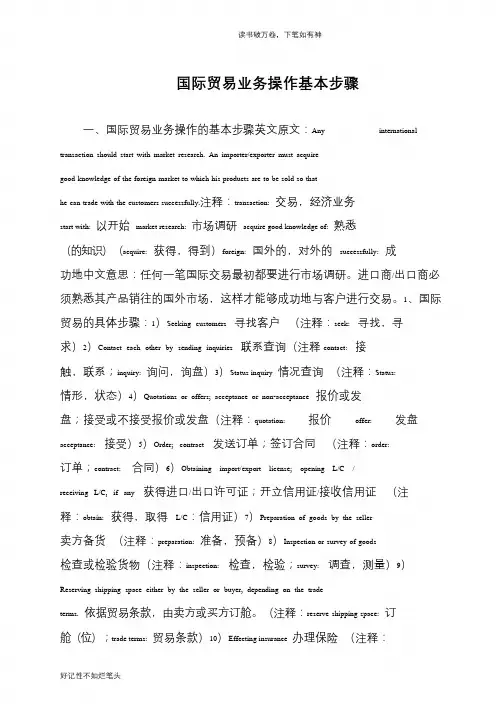
读书破万卷,下笔如有神国际贸易业务操作基本步骤一、国际贸易业务操作的基本步骤英文原文:Any international transaction should start with market research. An importer/exporter must acquiregood knowledge of the foreign market to which his products are to be sold so thathe can trade with the customers successfully.注释:transaction: 交易,经济业务start with: 以开始market research: 市场调研acquire good knowledge of: 熟悉(的知识)(acquire: 获得,得到)foreign: 国外的,对外的successfully: 成功地中文意思:任何一笔国际交易最初都要进行市场调研。
进口商/出口商必须熟悉其产品销往的国外市场,这样才能够成功地与客户进行交易。
1、国际贸易的具体步骤:1)Seeking customers 寻找客户(注释:seek: 寻找,寻求)2)Contact each other by sending inquiries 联系查询(注释contact: 接触,联系;inquiry: 询问,询盘)3)Status inquiry 情况查询(注释:Status:情形,状态)4)Quotations or offers; acceptance or non-acceptance 报价或发盘;接受或不接受报价或发盘(注释:quotation: 报价offer: 发盘acceptance: 接受)5)Order; contract 发送订单;签订合同(注释:order:订单;contract: 合同)6)Obtaining import/export license; opening L/C /receiving L/C, if any 获得进口/出口许可证;开立信用证/接收信用证(注释:obtain: 获得,取得L/C:信用证)7)Preparation of goods by the seller卖方备货(注释:preparation: 准备,预备)8)Inspection or survey of goods检查或检验货物(注释:inspection: 检查,检验;survey: 调查,测量)9)Reserving shipping space either by the seller or buyer, depending on the tradeterms. 依据贸易条款,由卖方或买方订舱。
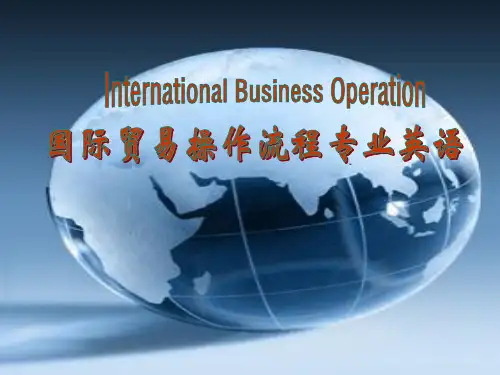
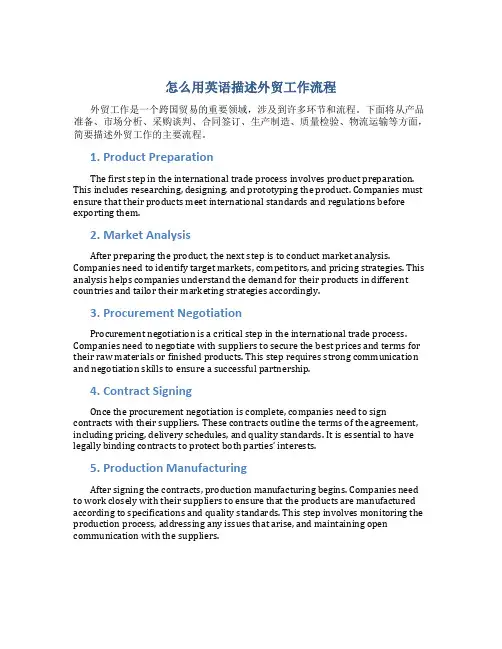
怎么用英语描述外贸工作流程外贸工作是一个跨国贸易的重要领域,涉及到许多环节和流程。
下面将从产品准备、市场分析、采购谈判、合同签订、生产制造、质量检验、物流运输等方面,简要描述外贸工作的主要流程。
1. Product PreparationThe first step in the international trade process involves product preparation. This includes researching, designing, and prototyping the product. Companies must ensure that their products meet international standards and regulations before exporting them.2. Market AnalysisAfter preparing the product, the next step is to conduct market analysis. Companies need to identify target markets, competitors, and pricing strategies. This analysis helps companies understand the demand for their products in different countries and tailor their marketing strategies accordingly.3. Procurement NegotiationProcurement negotiation is a critical step in the international trade process. Companies need to negotiate with suppliers to secure the best prices and terms for their raw materials or finished products. This step requires strong communication and negotiation skills to ensure a successful partnership.4. Contract SigningOnce the procurement negotiation is complete, companies need to sign contracts with their suppliers. These contracts outline the terms of the agreement, including pricing, delivery schedules, and quality standards. It is essential to have legally binding contracts to protect both parties’ interests.5. Production ManufacturingAfter signing the contracts, production manufacturing begins. Companies need to work closely with their suppliers to ensure that the products are manufactured according to specifications and quality standards. This step involves monitoring the production process, addressing any issues that arise, and maintaining open communication with the suppliers.6. Quality InspectionQuality inspection is a crucial step before shipping the products to the international market. Companies need to conduct rigorous quality inspections to ensure that the products meet the specified standards and are defect-free. This step helps prevent product recalls and customer dissatisfaction.7. Logistics TransportationThe final step in the international trade process is logistics transportation. Companies need to arrange for the shipping of their products from the manufacturing facility to the buyers. This involves coordinating with freight forwarders, customs agents, and other transportation providers to ensure timely and cost-effective delivery.In conclusion, the international trade process involves a series of interconnected steps that require careful planning, coordination, and execution. By following these steps, companies can successfully navigate the complexities of the global marketplace and expand their business internationally.。
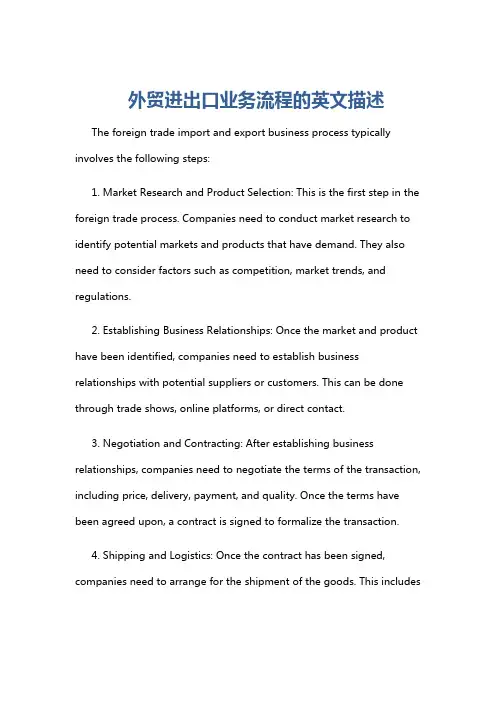
外贸进出口业务流程的英文描述The foreign trade import and export business process typically involves the following steps:1. Market Research and Product Selection: This is the first step in the foreign trade process. Companies need to conduct market research to identify potential markets and products that have demand. They also need to consider factors such as competition, market trends, and regulations.2. Establishing Business Relationships: Once the market and product have been identified, companies need to establish business relationships with potential suppliers or customers. This can be done through trade shows, online platforms, or direct contact.3. Negotiation and Contracting: After establishing business relationships, companies need to negotiate the terms of the transaction, including price, delivery, payment, and quality. Once the terms have been agreed upon, a contract is signed to formalize the transaction.4. Shipping and Logistics: Once the contract has been signed, companies need to arrange for the shipment of the goods. This includesselecting a shipping method, booking a shipping container, and handling customs clearance.5. Payment and Financing: Companies need to ensure that payment is received for the goods. This can be done through various payment methods, such as letters of credit, wire transfers, or cash. Financing options may also be available to help companies manage their cash flow.6. Documentation and Compliance: Companies need to ensure that all necessary documentation is completed and submitted accurately. This includes invoices, packing lists, and customs documents. They also need to comply with all relevant regulations and laws.7. After-Sales Service: Companies need to provide after-sales service to ensure customer satisfaction. This may include handling returns, providing technical support, or addressing any other issues that arise.In conclusion, the foreign trade import and export business process is a complex and multi-step process that requires careful planning, negotiation, and execution. By following these steps, companies can successfully engage in international trade and expand their business globally.。
![国际贸易操作流程专业英语Section I Business Negotiation Unit 1 Enquiries[精]](https://uimg.taocdn.com/099c4f4d5acfa1c7ab00cc01.webp)
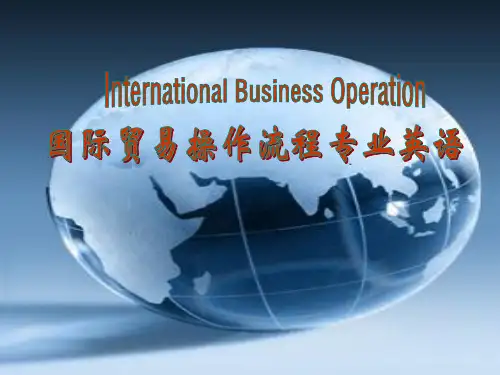
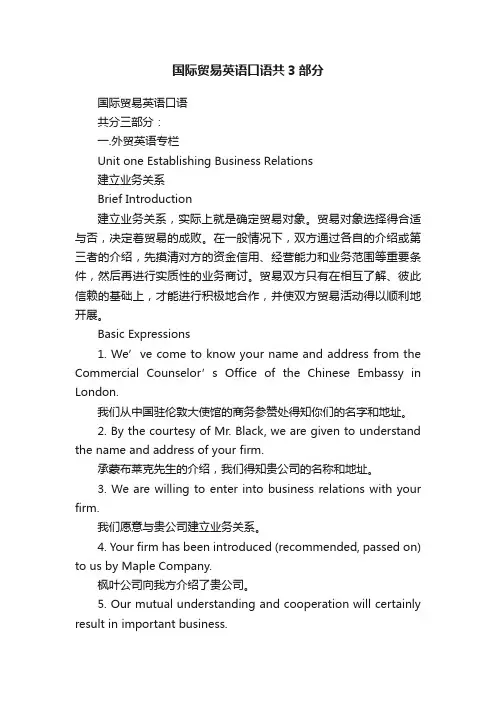
国际贸易英语口语共3部分国际贸易英语口语共分三部分:一.外贸英语专栏Unit one Establishing Business Relations建立业务关系Brief Introduction建立业务关系,实际上就是确定贸易对象。
贸易对象选择得合适与否,决定着贸易的成败。
在一般情况下,双方通过各自的介绍或第三者的介绍,先摸清对方的资金信用、经营能力和业务范围等重要条件,然后再进行实质性的业务商讨。
贸易双方只有在相互了解、彼此信赖的基础上,才能进行积极地合作,并使双方贸易活动得以顺利地开展。
Basic Expressions1. We’ve come to know your name and address from the Commercial Counselor’s Office of the Chinese Embassy in London.我们从中国驻伦敦大使馆的商务参赞处得知你们的名字和地址。
2. By the courtesy of Mr. Black, we are given to understand the name and address of your firm.承蒙布莱克先生的介绍,我们得知贵公司的名称和地址。
3. We are willing to enter into business relations with your firm.我们愿意与贵公司建立业务关系。
4. Your firm has been introduced (recommended, passed on) to us by Maple Company.枫叶公司向我方介绍了贵公司。
5. Our mutual understanding and cooperation will certainly result in important business.我们之间的相互了解与合作必将促成今后重要的生意。
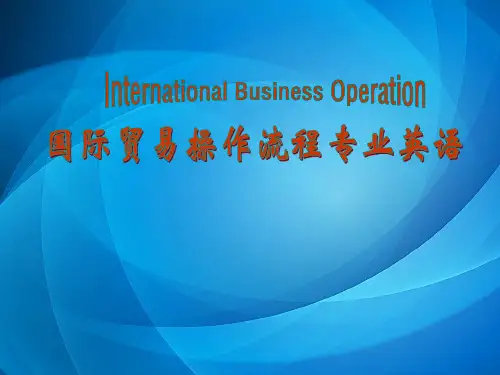
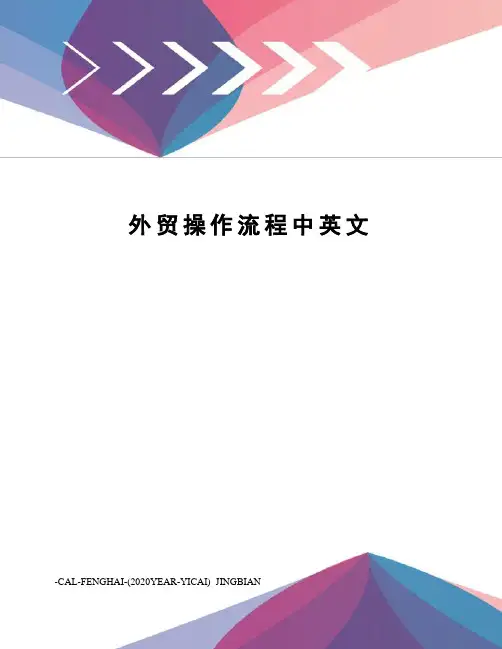
外贸操作流程中英文-CAL-FENGHAI-(2020YEAR-YICAI)_JINGBIAN1.外贸业务人员在国外采购商的询价,做出产品报价前,应了解客户基本信息,包括是否终端客户、年采购能力、消费区域,以及产品的用途、规格及质量要求,我公司是否能够生产等。
Before quoting, the Salesman should know the basic information about the clients, for instance, the end users or not, the annual order quantity, the places of consuming, and the products the purposes, specification, quality and the abilities whether our factories to meet.2.对于外商的邮件、传真,原则上在24小时内答复;特殊情况需要延期的,应及时向外商解释及大概需要的时间。
Generally as a rule, to reply the clients’ mails shall be within 24 hours after receiving; and please explain the reasons to the clients due to the things particular and need more time to deal with.3.对于外商的产品报价,原则上按照公司财务部门经核算后的价格表(外销)执行;公司财务部门根据市场状况及生产成本,定期进行核算,对产品价格进行调整。
Quotations will be according to the prices list (for oversea market) made by the company Accounting Department, which will make prices adjustments according to the market and the production cost at regular periods.4.对于定单数量较大,外商所能接受的价格低于我公司公布的价格的,业务人员应先上报部门经理批准实施;部门经理不能批复的,报总经理批准后实施。
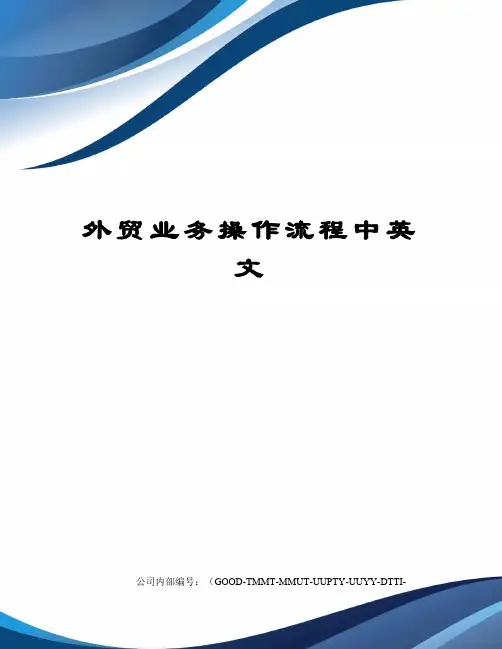
外贸业务操作流程中英文公司内部编号:(GOOD-TMMT-MMUT-UUPTY-UUYY-DTTI-外贸业务操作流程(中英文)1、业务人员在国外采购商的询价,做出产品报价前,应了解客户基本信息,包括是否终端客户、年采购能力、消费区域,以及产品的用途、规格及质量要求,我公司是否能够生产等。
Before quoting, the Salesman should know the basic information about t he clients, for instance, the end users or not, the annual order quant ity, the places of consuming, and the products the purposes, specifica tion, quality and the abilities whether our factories to meet.2、对于外商的邮件、传真,原则上在24小时内答复;特殊情况需要延期的,应及时向外商解释及大概需要的时间。
Generally as a rule, to reply the clients’ mails shall be within 24 h ours after receiving; and please explain the reasons to the clients due to the things particular and need more time to deal with.3、对于外商的产品报价,原则上按照公司财务部门经核算后的价格表(外销)执行;公司财务部门根据市场状况及生产成本,定期进行核算,对产品价格进行调整。
Quotations will be according to the prices list (for oversea market) m ade by the company Accounting Department, which will make prices adjus tments according to the market and the production cost at regular peri ods.4、对于定单数量较大,外商所能接受的价格低于我公司公布的价格的,业务人员应先上报部门经理批准实施;部门经理不能批复的,报总经理批准后实施。
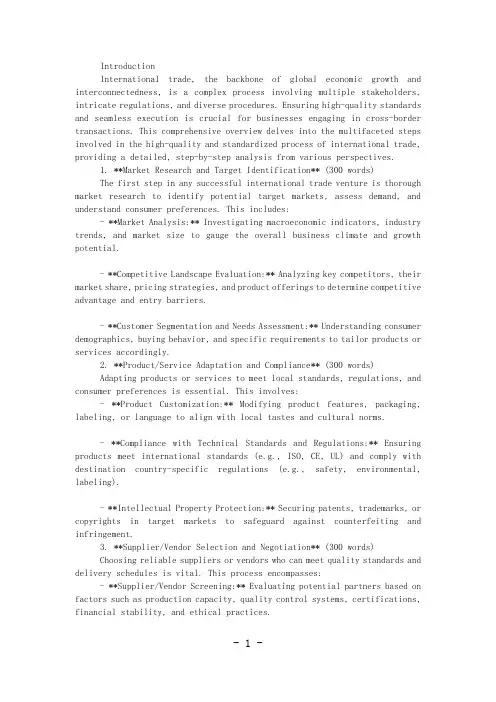
IntroductionInternational trade, the backbone of global economic growth and interconnectedness, is a complex process involving multiple stakeholders, intricate regulations, and diverse procedures. Ensuring high-quality standards and seamless execution is crucial for businesses engaging in cross-border transactions. This comprehensive overview delves into the multifaceted steps involved in the high-quality and standardized process of international trade, providing a detailed, step-by-step analysis from various perspectives.1. **Market Research and Target Identification** (300 words)The first step in any successful international trade venture is thorough market research to identify potential target markets, assess demand, and understand consumer preferences. This includes:- **Market Analysis:** Investigating macroeconomic indicators, industry trends, and market size to gauge the overall business climate and growth potential.- **Competitive Landscape Evaluation:** Analyzing key competitors, their market share, pricing strategies, and product offerings to determine competitive advantage and entry barriers.- **Customer Segmentation and Needs Assessment:** Understanding consumer demographics, buying behavior, and specific requirements to tailor products or services accordingly.2. **Product/Service Adaptation and Compliance** (300 words)Adapting products or services to meet local standards, regulations, and consumer preferences is essential. This involves:- **Product Customization:** Modifying product features, packaging, labeling, or language to align with local tastes and cultural norms.- **Compliance with Technical Standards and Regulations:** Ensuring products meet international standards (e.g., ISO, CE, UL) and comply with destination country-specific regulations (e.g., safety, environmental, labeling).- **Intellectual Property Protection:** Securing patents, trademarks, or copyrights in target markets to safeguard against counterfeiting and infringement.3. **Supplier/Vendor Selection and Negotiation** (300 words)Choosing reliable suppliers or vendors who can meet quality standards and delivery schedules is vital. This process encompasses:- **Supplier/Vendor Screening:** Evaluating potential partners based on factors such as production capacity, quality control systems, certifications, financial stability, and ethical practices.- **Price and Contract Negotiation:** Engaging in transparent and fair negotiations to establish mutually beneficial terms, including pricing, payment terms, lead times, warranties, and dispute resolution mechanisms.- **Long-term Relationship Building:** Fostering trust and collaboration through open communication, regular performance evaluations, and continuous improvement initiatives.4. **Incoterms and Logistics Planning** (300 words)Understanding and selecting appropriate Incoterms (International Commercial Terms) and efficiently managing logistics is crucial for cost-effective and timely deliveries. This involves:- **Incoterms Selection:** Choosing the most suitable Incoterm (e.g., EXW, FOB, CIF) based on factors such as risk allocation, cost responsibility, and control over transportation and insurance.- **Logistics Network Optimization:** Establishing partnerships with reliable freight forwarders, carriers, customs brokers, and warehouses to ensure smooth cargo movement, customs clearance, and storage.- **Supply Chain Visibility and Risk Management:** Implementing advanced technologies (e.g., blockchain, IoT) to enhance real-time tracking, predict disruptions, and mitigate risks associated with delays, theft, damage, or non-compliance.5. **Trade Financing and Payment Arrangements** (280 words)Accessing suitable financing options and securing timely payments is paramount for maintaining cash flow and mitigating financial risks. Key aspects include:- **Trade Finance Instruments:** Utilizing instruments like letters of credit, bank guarantees, export credit insurance, or factoring to mitigate payment risks and bridge working capital gaps.- **Payment Terms Negotiation:** Agreeing on payment methods (e.g., advance payment, open account, documentary collection) and timelines that balance buyer-seller interests and minimize risks.- **Foreign Exchange Management:** Implementing hedging strategies (e.g., forward contracts, options) to mitigate currency fluctuations and protect profit margins.6. **Documentation and Compliance with Export/Import Regulations** (270 words)Proper documentation and adherence to regulatory requirements are critical for avoiding penalties, delays, or shipment rejections. Key tasks include: - **Export/Import Documentation:** Preparing and verifying a comprehensive set of documents (e.g., commercial invoice, packing list,certificate of origin, import/export licenses) as per international and local regulations.- **Customs Clearance and Compliance:** Ensuring accurate classification of goods (using HS codes), valuation, and payment of duties and taxes. Staying updated on changes in trade policies, sanctions, and embargo lists.- **Trade Compliance Programs:** Implementing robust internal controls, training, and audits to prevent violations of export control laws, anti-bribery regulations (e.g., FCPA, UK Bribery Act), and economic sanctions.7. **After-sales Service and Customer Support** (292 words)Providing excellent after-sales service and customer support is crucial for building brand loyalty and repeat business. Key elements include: - **Warranty and Returns Management:** Establishing clear warranty policies, efficient return processes, and effective repair or replacement mechanisms.- **Customer Feedback and Complaint Handling:** Implementing systems to gather and analyze customer feedback, promptly addressing complaints, and using insights for continuous improvement.- **Localization of Support Services:** Offering localized customer support through multilingual resources, regional service centers, or online platforms, ensuring prompt and culturally sensitive assistance.ConclusionNavigating the high-quality and standardized process of international trade requires a holistic approach encompassing market research, product adaptation, supplier management, logistics planning, financing, regulatory compliance, and after-sales support. By meticulously executing each step and continuously refining these processes, businesses can harness the vast opportunities of global trade while mitigating risks and ensuring customer satisfaction. This comprehensive overview serves as a roadmap for enterprises embarking on or seeking to optimize their international trade ventures, fostering sustained success in the dynamic and complex landscape of global commerce.。
Foreign Trade Operation ProcessForeign trade, also known as international trade, refers to the exchange of goods and services between different countries. The process of foreign trade involves a series of steps that businesses must follow to engage in cross-border transactions.In this document, we will outline the typical foreign trade operation process in English.Step 1: Market ResearchBefore engaging in foreign trade, businesses need to conduct thorough market research to identify potential opportunities and risks in target markets. This includes analyzing market trends, customer preferences, competition, and regulatory requirements. By gathering market intelligence, businesses can make informed decisions about entering specific international markets.Step 2: Finding Suppliers or BuyersOnce a market has been identified, businesses need to find reliable suppliers or buyers for their products or services. This may involve attending trade fairs, networking with industry contacts, or using online platforms to connect with potential trading partners. Establishing strong relationships with suppliers or buyers is crucial for successful foreign trade operations.Step 3: Negotiating ContractsNegotiating contracts is a critical step in the foreign trade operation process. Businesses need to agree on terms and conditions with their trading partners, including pricing, payment terms, delivery schedules, and quality standards. A well-negotiated contract can help mitigate risks and ensure a smooth transaction process.Step 4: Regulatory ComplianceCompliance with international trade regulations is essential for foreign trade operations. Businesses need to obtain the necessary licenses and permits, adhere to import and export regulations, and ensure that their products meet quality and safety standards in target markets. Failure to comply with regulatory requirements can result in delays, fines, or even legal consequences.Step 5: Logistics and ShippingLogistics plays a crucial role in foreign trade operations, as goods need to be transported efficiently and cost-effectively across borders. Businesses need to coordinate with freight forwarders, customs brokers, and carriers to ensure smoothshipping processes. Managing logistics effectively can help businesses minimize lead times and optimize supply chain operations.Step 6: Payment and FinancingManaging payments and financing is another key aspect of foreign trade operations. Businesses need to agree on payment terms with their trading partners, choose appropriate payment methods, and consider options for trade finance, such as letters of credit or export credit insurance. Proper financial planning is essential to ensure that transactions are completed successfully.Step 7: After-Sales ServiceProviding after-sales service is essential for building long-term relationships with customers in foreign markets. Businesses need to offer support, warranties, and maintenance services to ensure customer satisfaction and loyalty. By addressing customer needs post-purchase, businesses can enhance their reputation and competitiveness in international markets.In conclusion, the foreign trade operation process involves a series of interconnected steps that businesses need to follow to engage in cross-border transactions successfully. By understanding and effectively managing each step, businesses can capitalize on international opportunities, expand their market reach, and drive growth in today’s global economy.。